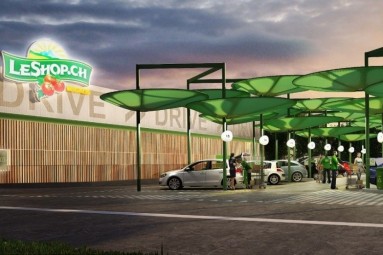Interview with Dominique Locher
Interview with Dominique Locher, former Managing Director of LeShop
We were able to talk to Dominique Locher about the developments in online retail and its effects on urban areas.

Which products are purchased online in the retail trade?
In the retail sector, a distinction must be made between digitizable and non-digitizable products. For the former, which include e.B music, books or travel agencies, 2/3 and more of all purchases are already made online. In the future, it will be around 90%. There are also digitizable products such as insurance and payment services, where brick-and-mortar retail is still "protected" today. In the future, however, such offers will also disappear.
For non-digitizable products such as .B.dem electronics retailers, around 35% of purchases are already made online. This market shows growth rates in the double-digit percentage range. In 5-6 years, every second purchase will be made online or every second shopping franc will be spent online.
Just a few years ago, it was assumed that clothes and shoes would not be purchased online because they had to be tried on when buying. The Zalando effect has proven the opposite and today around 20% of the textile sector is purchased online. Zalando had to invest massively in the initial phase and is now starting to earn money.

The share of online retail in the food sector is rather low at less than 2%. Why is this?
At around 2%, the share of online food retail in Switzerland is lower than that of the UK (around 6%) and France (around 4.5 – 5.0%), but still higher than in Germany, Spain, Austria or Italy. At 13%, South Korea has the highest share of online food retail. However, the food market is the largest market segment, so 2% in this market corresponds to around 8-9% in the textile sector.
With around 20% of the population shopping online, Switzerland has a similarly high percentage as the UK or France. However, the frequency of online shopping abroad is significantly higher; in the UK it is three times and France twice as high as in Switzerland.
In addition, there are major differences between rural and urban areas. In Zurich, the food online trade is likely to be around 4-6%, in London and Paris it is around 10%.
What is the reason for the relatively low proportion of online retail in the food sector in Switzerland?
The density of stationary food shops in Switzerland, including in rural areas, remains high; abroad, this is much lower. Existing supermarket chains have not yet taken up their mission to push online trading properly, which is often still regarded as a small plant. In some cases, there are still internal cannibalization fears with the core business However, the digital transformation is inevitable, because it is the answer to a customer need.
The food sector is the supreme discipline for online trading, because a large part is perishable fresh products and grocery shopping is very emotional. The largest online retailer, Amazon, tried for a long time with moderate success to sell food online until it realized that customers prefer a combination of online and brick-and-mortar retail. Therefore, he bought Whole Foods for US$ 13.7 billion, which led to sharp price reductions for the latter. Amazon has the great advantage of cross-subsidizing such margin reductions via other services (e.B. AWS z). Classic trading does not have this possibility. If such online providers come to Switzerland, there will be a fight for displacement in the food sector.
Which population groups shop online?
In particular, they are "digital moms", i.e. working mothers who juggle between work and private life, who run their errands online. More generally speaking, it is the "digital natives", i.e. people born in 1982 and younger, who shop online. Since this group will make up half of the population in just a few years, online trading is growing exponentially. For digital natives, visiting an online shop is even more natural than visiting a brick-and-mortar store.
The population in urban areas buys more online than those in rural areas. This may come as a surprise, as the density of brick-and-mortar stores in cities is higher than in the periphery. This has to do with the rather young and international population and with the higher level of employment of women in urban areas.
Has online retail lowered the barriers to entering the retail market?
Digitalization has significantly lowered the barriers to founding a company. Creating a website for online trading is a breeze. The digital world enables things that were not possible before. We are experiencing a kind of gold rush mood due to digitization. The younger generations want to realize something, they are willing to take risks. A new digital corporate culture is emerging, which challenges the traditional products and providers, as e.B. UBER or Airbnb do.
Thanks to the digital transformation and the measured data of the customers, companies can advertise tailor-made offers to the customer. There will be less and less of a "mass approach", i.e. a non-personalized service. Customers are often looking for something original, local or tailored to their person.
LeShop has been active in online trading for almost 20 years. How has it changed?
In the past, the customer was happy that he could order online and that the goods were delivered to their home. Today, the customer is much more demanding. It requires an attractive website on which the products look exactly as they are delivered. The home delivery should take place within the shortest possible time, or at the time determined by him. He is not willing to pay for delivery and does not accept minimum order quantities. Speed and precision as well as a choice between different channels are required. In brick-and-mortar retail, the customer buys in various shops, in online retail, the customer combines PC, tablet and smartphone as a place to shop.

How can online and brick-and-mortar retail be combined?
The combination of brick-and-mortar and online retail meets a clear customer need. There will be a distribution of roles between the two. Customers will order certain goods, in particular standardized (e.B. toilet paper), heavy (e.B. animal feed) or those for periodic (e.B. clothes) needs online and have them delivered to a place of their choice; be it e.B to your home, to your place of work or to the gym. Customers will also have goods delivered to a brick-and-mortar store (e.B. PickMup) in their neighborhood or on their way to work, where they stock up on fresh products for daily needs. Still other customers prefer the so-called DRIVE system, in which you drive up by car and only pick up the goods ordered online. There are around 3,200 such drive-ins. At LeShop.ch, we work together with over 100 Migros stores, to which the customer, the goods purchased online from LeShop.ch can have them delivered (pickMup). When picking up the ordered goods, the customer often still buys fresh products in the store.
What will brick-and-mortar stores look like in the future?
The brick-and-mortar store must offer what online retail does not have. It must be more than a place where the customer takes goods off the shelf and pays at the checkout. It becomes a showroom where goods are presented and the customer is advised. Not all product types will be present in the store; as a result, the product pressure in the store decreases and this becomes "lighter" and the sales area smaller. At the same time, the store will need space to temporarily store pre-picked goods ordered online until they are picked up by the customer. It will also be possible to return goods ordered online to the store.
The stationary store of the future will combine various products and services so that it becomes attractive for the customer to visit the store or to stay there longer. The store becomes a place of inspiration and encounter, i.e. away from the POS (Point-of-Sales) to the POP (Point-of-Participation). A transformation from "Building & Spaces" to "People & Places". The offer combination can also be made at different times of the day, so a shop can be a retail store during the day and a bar or coffee in the evening.
What other effects does digitization have on brick-and-mortar retail?
In the food sector, the big "hypermarchés" as they exist in France, among others, are becoming more and more common. Large formats are discontinued models, which can also be clearly seen in the death of shopping centers. The urban customer who is no longer traveling by car wants to satisfy his daily needs as spontaneously as possible and close to his place of work or residence. That is why grocery chains are once again launching more small-format shops that adapt their offer and opening hours to local demand. This brings you closer to the customer, be it physically or online with the supermarket in your pocket in the form of a smartphone.
Is there a revival of the small neighborhood shops?
As mentioned, small shops or service shops in neighborhoods and in the periphery can also benefit from online trading if they function as a kind of pick-up station where you can still buy fresh products, get certain services or meet with other people. Important is the complementarity of the online and offline formats. For older people, the store in the neighborhood is important because this is often their only point of contact with society.
What other effects will the change in retail have on urban areas?
Due to online trading, there will be a significant increase in courier services that will bring goods to private individuals' places of residence or work. In addition, the "business-to-business" area generates logistics trips. The costs for logistics will become cheaper in the future, as the volume of the delivered goods will be larger and the competition between different suppliers and models (e.B. bicycle couriers) will become tougher.
The inner cities become a place of leisure with a special experience. It depends on a clever combination of services, gastronomy and shops as showrooms. There will still be retail stores in the city centre, but they will have to change.
Shopping centers as they exist today, namely a big consumer trap, will no longer exist in the future. A smartphone has a larger offer than any shopping center and also offers more services. Only if the shopping centers offer more than shopping, they are fit for the future.
The accessibility of the inner cities and shopping centers as a shopping destination remains central. Shops in the city center or in shopping centers are becoming more showrooms with worlds of experience, in which the purchased goods are no longer transported home themselves, but this is done by courier services, or you can pick up the goods at decentralized pick-up stations. If all assortments of goods no longer have to be available in the store and the purchased goods do not have to be carried out of the store by the customer, there can also be shops with large products such as cars in the city center or in the shopping center.